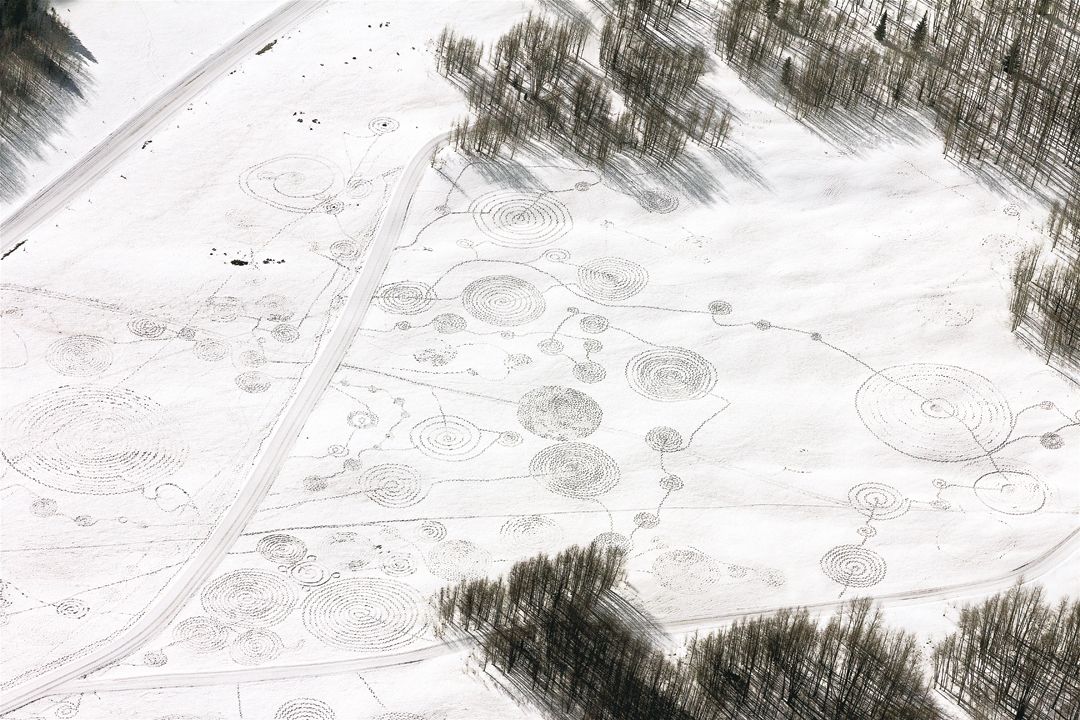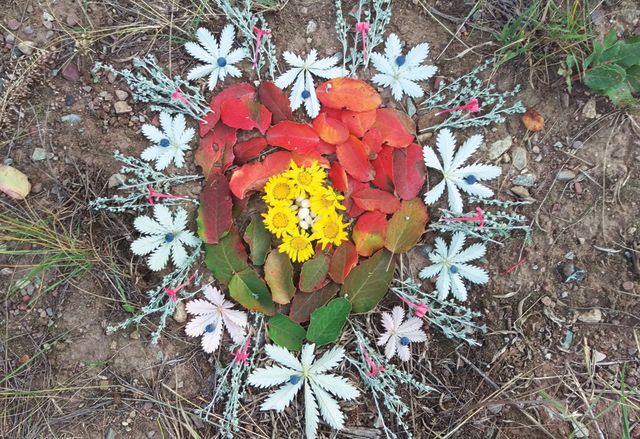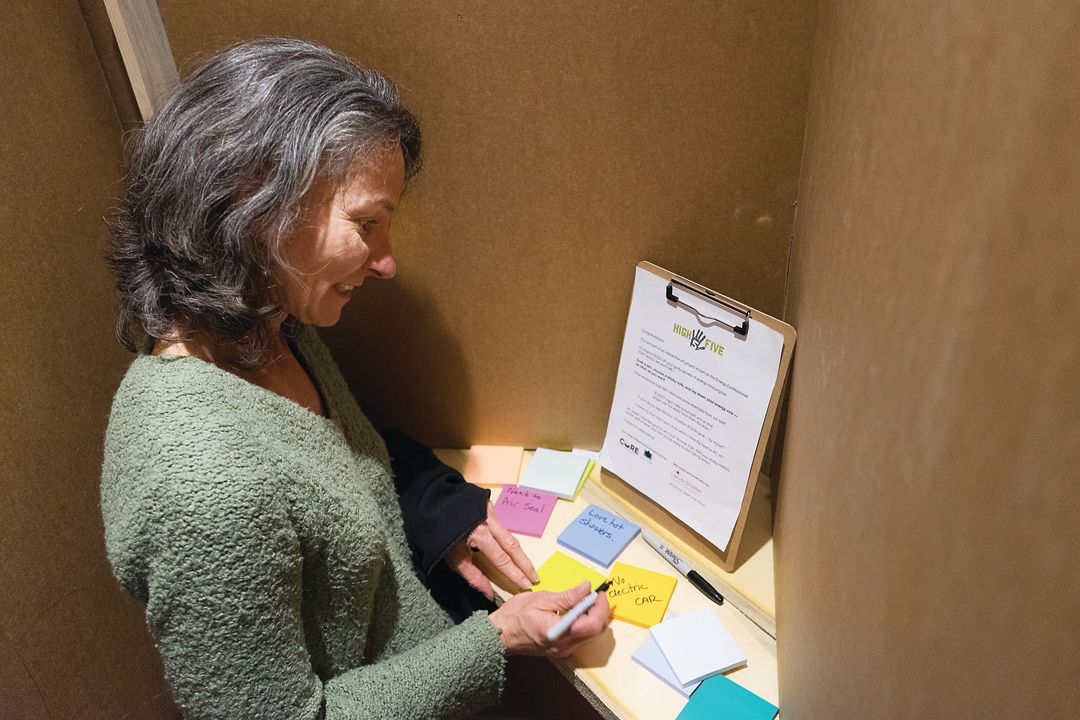Aspen CORE and Wilderness Workshop Get Creative to Raise Awareness

Artist Sonja Hinrichsen's snow drawing in Ashcroft outside of Aspen.
Image: Courtesy: Sonja Hinrichsen
When the Roaring Fork Valley’s Community Office for Resource Efficiency (CORE) planned a project with environmental artist Sonja Hinrichsen to promote climate awareness, no one could have predicted how much climate would ultimately—and ironically—play a role. The idea was for snowshoers to create patterns in the snow that would yield a large-scale work of art, while also demonstrating how each individual step we take to save energy makes a collective impression. It was also the first event in CORE’s brand-new High Five program, a call to action for the valley’s five high-elevation towns to engage in energy conservation.
“The weekend of our snow drawing in mid-March, we had 60-degree temperatures and four out of five of the potential sites had already melted out,” says Lara Whitley, community engagement and marketing manager for CORE. “It certainly added a sense of urgency to what we’re doing.”
Luckily, Ashcroft had been selected as one of the sites, and there was still enough snow at 9,400 feet to pull off the project, even if the wet, heavy snow presented its own set of challenges. Over the course of two days, 30 participants walked in the snow for a collective total of 89.25 hours to co-create the drawing with Hinrichsen.

Eco art heart by Celia Gregory that will be part of the We Love Pollinators living sculpture at The Art Base.
Image: Courtesy: Celia Gregory
The beauty of Aspen’s surroundings has long provided inspiration for artists, but, more recently, the intersection of art and the environment has spawned new “eco art” programs locally, with the aim of using creativity to make resource conservation more accessible to more people.
The project manager for CORE’s snow drawing event was Celia Dupps, a self-described “creative” who sculpts, illustrates, and designs mosaics in the Roaring Fork Valley. When living in Bali, Dupps founded the nonprofit Marine Foundation, which, among other things, builds underwater sea sculptures that function as living ecosystems, creating new habitat for fish, coral, and other ocean life. She discovered that art is a relatable way to involve people with social change. “People can absorb information through art in a way they can’t when they’re confronted with a set of data,” she says. “A creative approach is a powerful way to engage people in sustainable solutions to environmental issues.”
When Dupps moved here two years ago and found herself about as far from the ocean as you can get, she dove right into the mountain habitat, finding new avenues for eco art and community outreach. She joined forces with the Art Base to create Roaring Fork Art for Nature, a three-year program that integrates living sculpture with education and outreach. It kicks off this June with “We Love Pollinators,” a heart-shaped living sculpture made from flowers, including petunias, echinacea, marigolds, and bergamot.
“It’s inspired by the Jeff Koons dog at the Guggenheim Bilbao, and the structure is actually quite complex,” Dupps says. The piece will be on display at the Art Base campus in Basalt. A corresponding website for the project and social media campaign will provide info about local pollinators—bees, hummingbirds, moths, butterflies, and other insects. “We want people to take photos of the life in the artwork so we can catalog all the pollinators it attracts,” explains Dupps.

CORE's Energy Confessional at a recent event at The Launchpad in Carbondale.
Image: Craig Turpin
CORE, meanwhile, followed up its snow drawing event with the “Energy Confessional,” a mobile art installation that invites participants to enter a private booth and own up to their guilty energy practices by writing them on a Post-It note and sticking it on the wall. “It’s part pressure-release valve, part prayer wall,” says Whitley. “The intention is to encourage people to fess up, let go, and take action.” At two recent launch parties for High Five, the nonprofit collected more than 200 confessions, which will be used to tailor the content of future outreach. Later this summer, CORE will sponsor another community art project in the lower Roaring Fork Valley.
One of the longest-running local art and nature programs comes from Wilderness Workshop, which has been hosting its Artist in Wilderness residency since 2008. The program was created in honor of the late Dottie Fox, one of the nonprofit’s co-founders. A small group of artists is selected from dozens of applicants nationwide to come to Aspen for a week each summer and create nature-inspired pieces, including one that’s then auctioned off to raise money for the nonprofit. (One of this year’s five participants is Carbondale’s Andi Korber.)
“The program enables us to expand our audience and underscore the beautiful relationship humans can have with nature, so the benefits are twofold,” says Rebecca Mirksy, development director at Wilderness Workshop, which celebrates its 50th anniversary this summer.
Forging the connection between art and nature makes it possible for conservationists to both make the science behind their causes more relatable and create a visual impact. Nothing painted a better picture, so to speak, than CORE’s snow drawing. Due to the unseasonably high temperatures, the drawing vanished the very next day—and it doesn’t take a climate change expert to understand that.













































